Zeng Houyi's chimes continue to compose a common "world memory" for mankind
In the long history of the development of Chinese civilization, the music from the "Era of Confucius", the chime of Zeng Houyi, has endured for more than 2,000 years. "National Treasure" continues to compose a common "memory of the world" for mankind.

Discovery: Ritual music scene that shocked the world
In September 1977, a group of troops accidentally discovered a large tomb in the early Warring States period when they were leveling the hilltop and building a factory in Leigudun, Suizhou. In March 1978, the archaeological team headed by Tan Weisi of Hubei Provincial Museum began field investigation. Feng Guangsheng, who was in his early 20s and is currently a research librarian at the China Millennium Monument World Art Center, also came to the construction site. This was his first exposure to archaeology as a music student.
Recalling the scene of the opening of the tomb of Marquis Yi of Zeng, Feng Guangsheng still couldn't hide his excitement: "When the tomb was opened, what I saw was a 'swimming pool' of more than 200 square meters, and the tomb was full of water. However, with the motor of the submersible pump With the sound, the water level slowly dropped, and I, like everyone present, was completely stunned."
Slowly emerging from the water are a wooden column, three-tiered beams, and pieces of ancient bronze bells hanging under the beams. When the water falls, the set of bronze bells with such a large scale, majesty and a large number of bronze bells has survived for more than two thousand years. Only two Yong bells fell into the soil.

This is a "super ancient tomb" with an area of 220 square meters and six times larger than the Mawangdui Han Tomb in Changsha. After cleaning and testing, there are 65 pieces of Zeng Houyi chimes, arranged in eight groups, hanging on a three-layer bell frame, and the total weight of the full set of chimes is 2.5 tons.
So far, Zeng Houyi's chimes are still the largest set of chimes unearthed in China, the heaviest in weight, the most complete in rhythm, and the most magnificent. Its majestic and perfect "curve hanging" frame, and the matching chime of Zeng Houyi, completely and clearly present the "xuanxuan" system of the Zhou Dynasty princes, and interweave with other bronze ritual vessels to create a picture that is close to reality. ceremonial scene.
Among these rare musical cultural relics, not only the original Zeng Houyi chime bell, but also nine kinds of 125 musical instruments, including the chime, qin, se, panpipes, and bamboo chi, were unearthed in the tomb of Zeng Houyi at the same time.
Following this, the hometown of Zeng Houyi, "Zeng Kingdom", which is rarely recorded in historical materials, has once again entered the field of vision of archaeologists and historians, and the "mystery of Zeng Kingdom" can be peeled off layer by layer...
Research: "Two Tones in One Bell" Book of Temperament
As soon as it was unearthed, this rare cultural relic entered the field of view of researchers and the public in an open state. Experts mobilized from all over the country gathered in Sui County to conduct research.
Long before Zeng Houyi's chimes, experts in music and cultural relics including Huang Xiangpeng had visited Shanxi, Shaanxi, Henan, Gansu and other places successively to study the unearthed chimes and put forward the view of "one bell with two tones". However, this new achievement is often dismissed as "nonsense", and no one believes that there are two different tones on a single clock. It was not until the excavation of Zeng Houyi's chime bell that the "one bell and two tones" of Chinese pre-Qin musical bells was generally recognized by the world.
There are more than 3,700 inscriptions on the bell body, bell frame and wall clock components of Zeng Houyi's chime. These inscriptions not only marked the rhythm of each bell and the rhythm scale names, but also clearly showed the corresponding relationship between these scale names and the rhythms of Chu, Zhou, Qi, Shen and other countries.

Musicologists found that Zeng Houyi Zhongming is a complete set of musical rhythm system, with a sound range spanning 5 octaves, only one octave less than that of a modern piano, and a complete central sound range of 12 semitones. This is a golden rhythm scripture, and its unearthed is enough to rewrite the history of ancient Chinese music and the history of ancient music in the world.
The peak of the music culture of Zeng Houyi's chime and axis era irrefutably shows that in the fifth century B.C., China already had a twelve-tone system, with the ability to rotate the palace and change the key, and have good music performance performance. The discovery of "one bell with two tones" and "twelve rhythms" is a great contribution made by the Chinese to human music culture in the fifth century BC.
Openness: the "special envoy" of cultural exchanges resounding between China and foreign countries
In 1983, the first copy of Zeng Houyi's chimes passed the national acceptance, and its "sound" and "shape" basically achieved the effect of "shape-like" and "sound-like". During the National Day in 1984, the specially established Hubei Provincial Chime Orchestra was invited to Beijing to present the first large-scale national symphony for the birthday of the Republic with a copy of Zeng Houyi’s chime, which had just won the first prize of the Ministry of Culture’s Science and Technology Progress Award.
Chime bells have witnessed major events since the founding of New China, and also shortened the distance between China and the world. As a Chinese cultural messenger, chimes have traveled and performed in dozens of countries and regions, and many foreign leaders have personally played them.
In 1997, when Hong Kong returned to the motherland, the composer Tan Dun composed the large-scale symphony "1997: Heaven, Earth and Man". Zeng Houyi's chimes took to the world stage with powerful and deep music; The original sound of the chime and the sound of the jade chime made the grand and solemn award ceremony music of "Sound of Gold and Jade" and "Sound of Gold and Jade"...
In July 2018, Ms. Elizabeth Bradley, representative of the Musical Instruments and Music Collection Committee of the International Association of Museums and Director of the Musical Instrument Department of the Metropolitan Museum of Art in New York, USA, welcomed her "second encounter" with Chime. She told reporters, "Chime bells are one of the best ways for people around the world to understand ancient Chinese music. It preserves the musical memory of human beings in the way of mutual confirmation of sound and text, and is a well-deserved heritage of the world's memory."
As the land where the chime of Zeng Houyi came from, the site of the Leigudun ancient tomb complex in Suizhou, Hubei is currently accelerating the construction of the Leigudun National Archaeological Site Park, and the dehydration restoration and protection of the site of the tomb of Zeng Houyi is about to start. Chime Bronze Ancient Town and International The musical instrument trading city is also expected to be completed here.
 渝公网安备 50010702504639号
渝公网安备 50010702504639号